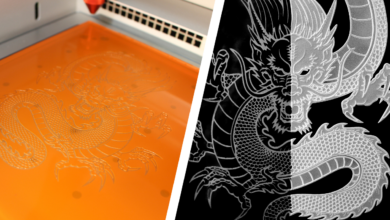
A question that many trophy and award shop owners have asked me during my 30 years in this industry is, “Should we add glass and crystal to our offerings?” This question creates logical follow-up questions: Why add glass and crystal products? What products should I add? How do I show it? How do I price it? How do I promote it? And, what resources do I need to do it? Spoiler alert: Answers below…
Why add glass & crystal products?
When I entered the glass and crystal award industry in 1992 very few traditional trophy and award shops offered them. The industry consisted mainly of crystal gift shops, large established glass and crystal engraving companies, and a small number of the larger trophy and award retailers. The industry also consisted of a considerable number of glass and crystal engraving hobbyists who worked out of their basements or garages.
In those days, the variety of blank glass and crystal products available for engraving was minimal. The designs were basic, and it was not until the mid to late 1990s that optic crystal products were introduced and by then, the number of glass trophy product designs had grown exponentially.

By the early 2000s, the volume of glass and crystal products on the market had started to take significant market share from traditional trophy and award products, like cups, trophies, and plaques. At this point, several of the major industry trophy suppliers and distributors had already taken note and were adding glass and crystal products to their own lines.
So why was this happening? First, glass and crystal products have a very high perceived value. Because they are heavier than most other trophy and award products, they are perceived to be more expensive than they really are, so profit margins can be very good.
Second is the sparkle factor. With edges, facets, and bevels that reflect light in all directions, they are eye-catching. Add to this a nice, deep abrasive etch and perhaps a touch of color fill, and you have a trophy or award that looks classy and expensive.
Two of the most famous examples of this, which have stood the test of time, are the JD Powers Award introduced by the Southern California Trophy Company in 1990, and the CMA (Country Music Award), originally designed by Frank Waggoner using walnut but changed to Italian hand-blown glass in 1983. These are two very good reasons why you should consider adding glass and crystal to your offerings.

What products should I add?
As with almost any product line, the 80/20 rule will apply. This means that 80 percent of your sales will most likely come from 20 percent of your products.
The cost of glass and crystal product blanks will range from a low of about $5 to well over $100. This will put your finished product within a $20-$300 recommended retail cost range. From my experience, the majority of your sales will come from products in the $25-$125 retail cost range. This means you should select the bulk of your range of blank glass and crystal products that cost between $5-$45.

At a blank cost higher than $45, your sales will taper off considerably, so only select a small range of these higher-cost products to show but limit the number of styles and sizes. The top shapes to select should include diamonds, peaks, circles, towers, bowls, vases, and paperweights.
How do I show it?
When it comes to displaying glass and crystal products there are a few important factors to consider. The first is to always display engraved or decorated products so that your customers can see what the product looks like finished.
Blank products do not show like a finished product does. Lighting plays an extremely important factor when displaying glass and crystal. An enclosed glass show cabinet with integral LED lighting is always an attention-getter and keeps products clean and dust-free.
Open shelving will require constant cleaning as the products are more likely to be handled. Whichever method you use, glass and crystal displays (and sells) best when it is spotless.
How do I price it?
Pricing involves many factors, but I will try to simplify the process. The first is to know your actual blank product cost (meaning the cost landed at your door). For simplicity, let’s assume our landed blank product cost is $20.
Next, you need to estimate the cost for preparing artwork and engraving and any assembly and packaging needed (labor and materials). Let’s assume the engraving and assembly cost is $20. We now have a product cost (total cost of goods) of $40.
For established businesses in similar industries, we would normally seek to achieve a 50-60 percent gross margin. This would equate to a selling price of $80 to achieve a 50% margin or $100 for a 60% margin. Your gross margin percentage is Selling Price minus Actual Cost divided by Selling Price.
For example: Selling Price is ($80) minus Actual Cost ($40) divided by Selling Price ($80) = 50% gross margin.
Now comes the hard part. What factors are known that will affect your profit margin? For example, does the finished product have direct competition? Is the product unique, and therefore has little or no competition? Is the quality of your product and engraving better than the competition? How much lead time is your customer giving you (is it a rush order)? Is the order a single award, or are multiple quantities involved?
These are only a few of the factors that can affect your profit margin. In general terms, only unique products with little or no competition can justify margins approaching or exceeding 60%. A 50% margin (double your actual cost) is a good target starting point.
If multiple quantities are involved it would be normal to apply some discount, which would reduce the margin, but you would typically see reduced labor costs that will offset this and help improve your margins. Also, if you have competition, you might need to reduce your margins to retain a client or win a new client.
Another simpler pricing method is to take the actual glass or crystal blank product cost (without artwork preparation, engraving, assembly, and packaging costs) and multiply it by 4. This method will typically come very close to a 50% gross margin after all costs are covered.
How do I promote it?
As I have already mentioned, how you show it will have a huge bearing on sales. The quality and cleanliness of your showroom samples and the engraving quality are all extremely important. First impressions are a key promotional factor for glass and crystal.

One very important selling point is that glass and crystal products are manufactured using a raw material that is infinitely recyclable; it can literally be recycled over and over again. Glass is a product that uses only natural minerals to make it, namely silica, soda ash, and lime.
For eco-conscious customers, products that are recyclable can have a clear sales advantage. Optic crystal essentially uses the same minerals as glass, and for lead crystal, lead oxide is added. Lead crystal, however, is gradually being replaced with lead-free versions such as crystalline.
What resources do I need?
There are two options to consider: subcontracting or engraving in-house. Subcontracting does not entail the purchase of equipment, but engraving in-house obviously does. Glass and crystal products are most commonly engraved using abrasive etching (sandcarving) equipment. This process also requires equipment to develop artwork and produce photoresist masks.
A typical abrasive etching setup can run between $6,000 to over $12,000, depending on size and features. It also requires an air compressor unless your shop already has one that is large enough. Perhaps your shop already has a CO2 laser or UV-cure direct color printer. These two processes can be used on certain glass and crystal products, but abrasive etching is essential for the majority. A full range of abrasive etching equipment is available from IKONICS Imaging and Rayzist.

Many of the glass and crystal blank suppliers now have in-house engraving and decorating capabilities. This was not the case when I started in this industry. We designed, produced, and sold only glass and crystal blanks and did not compete with our engraving customers.
Fast forward 25 years, and most glass and crystal blank suppliers now also have a full range of decorating methods. For those who do not wish to invest in capital equipment initially, these one-stop-shop suppliers offer a good cost-effective alternative. It’s also a great way to start out; then, you can consider the purchase of your own equipment when your sales have become well established.







